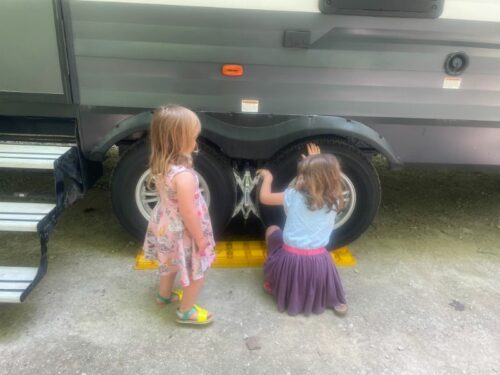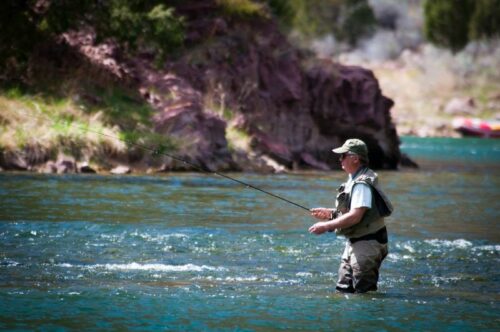Scenic views, exciting road trips, and never having to set up or take down a tent are just some of the amazing perks of van life. Not to mention, the Instagram-worthy photos that many #vanlife bloggers share that make us want to sell everything we own and live in a van down by the river – or is that just me?
So you head to the internet, search for a converted Sprinter van and realize you just might have to actually sell everything you own to afford one.
Do not panic. It is possible to have the complete #vanlife experience with a much lower price tag. Budget van builds are popular and much more affordable, just slightly less aesthetic. Here’s one of mine below!

Stick with me. I have rounded up the best and most commonly used vans for a DIY budget build and everything you need to get on the road as quickly and cheaply as possible!
STEP 1: CHOOSE A VAN
Sprinter Vans
Mercedes definitely knows what they are doing when it comes to vans. The Sprinter van is an iconic and staple image in the vanlife community. They offer multiple lengths and height options that provide a lot of customization for van build-outs from the ground up.
These vans start at around $38,000 for a base model with the standard roof and the shortest wheelbase. While that price tag may not seem too pricey for some, buying a fully converted Sprinter van can run between $100,000 to $200,000 or even more for custom builds or for luxury brands, like this Airstream Interstate RV:

DIYing your van build-out will obviously cost you less financially. Labor is a large chunk of the price tag and when you choose to go with a professional to upfit your van, they will use more expensive, but not necessarily better, materials.
If you’re comparing a Mercedes Sprinter to a Ford Transit, check out this comparison.
Budget Options
While Sprinter vans may seem like the only logical or convenient option for van builds, that is far from the truth. There are many more financially sound options on the market.
While choosing my budget van, I chose a 1999 Chevy Express Conversion Van. Chevy Express vans were also rebadged and sold as the GMC Savana. I found my van with 130,000 miles located in Central Illinois for $3,500. The price tag was one of the main reasons I chose this van over any other conversion or cargo van styles. I will be referencing my DIY budget van build throughout this article.
The Ford Econoline van is a great option for a van build-out. A decent Ford E-Series van will cost you anywhere from $5,000- over $15,000 depending on the condition and miles. Ford stopped making the passenger and cargo van version of the E-Series in 2004. If you are looking for a newer van, this may not be your top pick. However, these vans are known to be reliable and have a good foothold in the vanlife community.
Chevy G-Series vans are another budget-friendly option for a DIY van build. These vans are older as well, Chevy stopped making them in 1996, however, the Chevy G-Series is a staple in the vanlife world. Even better, these vans can be found in good condition for between $5,000 – $12,000!
While Dodge stopped making the Dodge Ram B Series Van in 2003, these vans paved the way for the Dodge Promaster Series vans that many vanlifers splurge on today. Their square bodies and reliable engines make these B Series vans a staple in the vanlife community. The best part is the price tag. You can find these vans for anywhere from $3,000 – $10,000 making them one of the best value-for-money vans on the list.

How to Choose a Budget Van
Choosing a brand or model of van is not as important as other aspects of the buying process. I tried not to get hung up on brands, aesthetics, colors, or location while van shopping. I spent hours scouring Facebook marketplace, used car websites, and driving to lots of used car dealerships comparing vans. Here is what I was looking for:
- Choosing a van with low (for its age) mileage was important for me. Finding a van that is over a decade old, or in my case, 2 decades, with less than 80,000 miles was my goal. I ended up with my Chevy Express at 130,000 miles. After checking over the maintenance records, I felt comfortable with the miles knowing it had been well cared for.
- Many older conversion and cargo vans are known to have a good amount of rust either underneath the van or on the lower parts of the sides. Somehow, the Chevy had almost no rust at all, which was a major perk and made me incredibly interested in this van. Some rust is not too much of an issue, but avoid anything that has rust holes or widespread rust, it won’t be salvageable or fixed and can affect structure and safety.
- While doing research for vans, I spent a lot of time on online van forums to learn about these types of vans. Sometimes, certain brands and models have consistent problems that are common amongst makes and years. For example, it is not uncommon for older Chevy Express vans to have intake manifold gasket leak and spyder injection failures. Knowing these problems are common upfront, I was better able to deal with and check the van over before purchasing.
STEP 2: DESIGN YOUR VAN BUILD
While many vanlife creators and bloggers have a beautiful setup, it can be impossible and inconvenient to try to cram everything into a smaller budget van build. Most of the images you see online of vanlife content are from creators who have the largest model Sprinter van with the extended wheelbase and higher roof, allowing for a set kitchen, bathroom with a shower, and permanent bed.
Raise The Roof
While you can’t extend the wheelbase of your budget van, you can add some height! There are toppers you can add to your van! You can pay a company to add either a pop up style or fiberglass high top to your van. However, the budget-friendly version will have you adding one yourself. Purchasing either a pop-up style or fiberglass high top will set you back some financially, but you can also DIY one yourself.
Pop-Up
Pop-up high tops allow for flexibility. You can pop up the roof while you are parked, allowing you to stand up properly without worrying about hitting your head. The benefit of a pop up style high top is that you can keep it down while driving, allowing for a more aerodynamic cruise, thus better gas mileage. With gas prices soaring higher than $5 a gallon, doing anything to add some bang for our buck is important.

Ranging from $10,000 and $20,000 with installation, these are not cheap. I decided I did not need a raised roof in my van, as I was sticking to a “bare minimum” build to get on the road as quickly as possible. Checking facebook marketplace and other resale sites is a great way to find these things for cheap(er). You may be able to find a pop up high top for cheap or even free! You can buy installation kits online, making this DIY project attainable even on a budget.
Fiberglass
If you get lucky, you may find a conversion or cargo van with a fiberglass high top already in place. These are permanent structures, meaning they will not be able to be pulled down in transit. These offer better protection from the elements and are more durable than a pop up style high top. They also tend to be created to allow the van to remain aerodynamic. For older vans, you can purchase a fiberglass high top for pretty cheap.
This website allows you to choose your van model and have a custom top built for you. With a median price of $5,000 per high top without installation, you can pick up your custom at their storefront. Installation is pricey, but you can find videos on how to do it yourself on YouTube. Sometimes you can salvage a high top from another van or location so keep an eye out.
STEP 3: THE BARE NECESSITIES
Once you have decided on and purchased your future #vanlife vehicle, the fun part begins. It can be easy to get carried away while planning out the van, so let’s break it down into 3 parts: the kitchen, the bathroom, and the bedroom.
Cooking in the Wilderness
Kitchen designs range dramatically depending on the lifestyle you want to live. When I converted a minivan, I used a portable camping stove, a cutting board, and a TJ Maxx bag full of pots and pans as my kitchen. My food was stored in a classic cooler that I stored in my trunk.
While building out the Chevy Express, I purchased some 36-inch base cabinets and countertop from a local salvage shop. This cost me about $50 for everything. I then stored a propane tank under the cabinet and connected it to the camp stove. I decided against a fridge again, but you can purchase propane fridges starting around $300 and work those into your build.
For a sink, I used a 5-gallon water jug and attached a water pump to it. I used portable water from the campgrounds, but I only used this water for washing and not for drinking. I also used this technique for my showering while on the road.
Sleeping Under the Stars
I wanted a permanent bed in my van. So I built one. Using 2×4 planks and wooden slats, I created a bed frame in the back of the van. I raised the bed frame to allow room for storage underneath. This is a great place to store bikes, snowboards, skis, or other outdoor equipment. Another option is to create a seating area and table in the back of the van that transforms into a bed with the rearrangement of cushions. I chose not to do this because it seemed like way more work and I do not need a dedicated seating space.

When Nature Calls
Bathroom builds are what I think may be the trickiest part of van builds. There is so much plumbing involved if you want to put in a black or gray tank. Adding a bathroom or toilet to your van is not necessary, but can be a convenient option especially if you plan on staying off grid or boondocking.
A portable toilet is a great option for van builds that do not have their own bathrooms built in. These are compact and convenient toilets that can be stored under the bed or in cabinets when not in use. Another option if you do not want to deal with plumbing is the good old bucket toilet. These are the cheapest option next to using public facilities or doing your business in the woods. Also budget friendly is a good old cassette toilet, also known as a chemical toilet. These toilets are not as portable and often can be attached to your van’s bathroom, if you are lucky enough to have space for one. Choosing a portable toilet is a personal decision and you cannot really go wrong with any of the options.
Take a Bath, Hippie
Showering is another beast altogether. Waterproofing a section of the van for a shower stall can be difficult and inconvenient. In most cargo or conversion vans, I do not recommend trying to install a shower. If you want, you can choose to shower at campgrounds, truck stops, or travel centers.

Another tip of the van life community is to join a gym that is nationwide, you can always use their shower facilities! An outdoor shower tent with a camping bag shower allows you to take a shower outdoors with proper privacy and warm water.
Off-Grid Power
Adding solar panels can be a pricey and time-consuming endeavor. For those who are not comfortable with electrical work, having a professional install a power bank and then wire the van for electricity can be expensive.
For budget builders, I recommend looking into generators or battery banks. You can find diesel, gas or propane generators, or solar battery banks.
I chose not to outfit my van with any additional power sources. I see the value of adding these items to a van build, but for my lifestyle, I chose to spend money and energy in other places.
STEP 4: GATHERING THE GOODS
Between finding a van, updating the maintenance, raising the roof, and adding all the internal upgrades, the financial aspect of a van build adds up quickly. To help take some of the expense out of your van build, try looking for items secondhand. Finding things on Facebook Marketplace, thrift stores, garage sales, and salvage stores allows you to get nice items at a heavy discount.
Even things like bedding, curtains, storage containers, tents, plates, and bowls can be found at a discount. Joining Facebook or other online communities of other vanlifers can allow you to find items they are selling. Trading is another great option to get items for free or at a heavy discount.
STEP 5: DIY VAN BUILD
The best way to save money is to DIY the van build yourself. Anytime you have a professional work on your vehicle, it costs a large amount more due to the parts being marked up and paying for the professionals’ time and expertise.
Learning how to DIY a van can feel overwhelming and scary at first. Watching videos on YouTube and joining vanlife communities online or in person can help teach you ways to build out your van.
Sometimes tools can be extremely pricey. You can rent many tools through local hardware stores and sometimes even your library has a tool section. Pawn shops almost always have power tools for sale at much less than market value.
Some things during a build would require too much time or energy to get done by yourself. Picking and choosing which items on your list need a professional and which you can tackle yourself can save you time, money, and stress in the long run.

SUMMARY – HERE’S WHERE TO START!
Vanlife can be exciting, liberating, and adventurous which is alluring to people from all walks of life. But learning where to start can be overwhelming and intimidating. The cost of purchasing a state-of-the-art converted Sprinter or Promaster van can cost upwards of $200,000. But you can successfully convert an older van for much less by DIYing and choosing what you really need in your van.
Choosing your own van and creating the interior layout and amenities allows you to control the financial aspect of the van build. Hiring professionals only for aspects you do not feel comfortable doing will save you both time and money while teaching you many life skills. Learning the ins and outs of your van gives you the knowledge and confidence to fix things when you are out on the road as well.
Not every DIY van will be as beautiful or aesthetic as the Instagram-worthy #vanlife vans often featured on Instagram or other social media, but your van can take you to the same places. After all, isn’t that what #vanlife is really all about?
Sara Sabharwal is a modern digital nomad exploring the world one road trip at a time. She splits her time between North America and India and has yet to find a place that she didn’t fall in love with. Her favorite destinations include dark sky parks and forested mountain ranges. My dream is to live in a van down by the river, which I luckily get to do 3-6 months out of the year.
-
Sara Sabharwalhttps://changingears.com/author/sara-sabharwal/
-
Sara Sabharwalhttps://changingears.com/author/sara-sabharwal/
-
Sara Sabharwalhttps://changingears.com/author/sara-sabharwal/
-
Sara Sabharwalhttps://changingears.com/author/sara-sabharwal/









